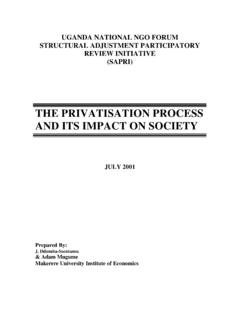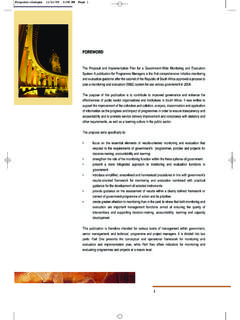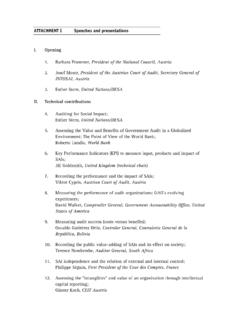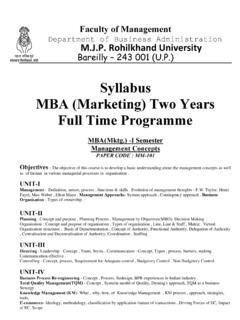Transcription of Workshop on State-Owned Enterprises in the …
1 Workshop on State-Owned Enterprises in the development process Paris, 4 April 2014 OECD Conference Centre, Room 4 THE EVOLUTION OF STATE owned Enterprises IN SOUTH AFRICA by Edwin Ritchken This paper serves as background material for the Workshop on SOEs in the development process taking place in Paris on 4 April 2014. It was prepared by Edwin Ritchken working as a consultant for the OECD Secretariat. The opinions and views expressed and arguments employed herein are those of the author and do not necessarily reflect or represent the official views of the OECD or of the governments of its member countries. 1 The Evolution of State owned Enterprises in South Africa Executive Summary Over the twentieth century, the growth and development of the South African economy was overwhelmingly based on the mining and export of diamonds and gold and then in the second half of the century, the export of bulk and some processed resources, such as coal, iron ore, aluminum and manganese.
2 The process of establishment, operational and commercial practices and culture of the key infrastructure utilities (which had a not for profit mandate and were initially called State owned Corporation (SOC) and on their commercialization were to be re-named State owned Enterprises (SOE) later in the century) were integrally shaped by their role in the resource based economy, although they had their origin in the desire by the state to move beyond a dependence on mining and foreign Enterprises . The state owned resource processing companies established in the first half of the century were part of a project to diversify the economy, although their growth was often enabled by, and dependent upon, the mining houses.
3 The electricity utility company (Escom which was later to become Eskom in the 1980s) also enabled the establishment of an energy intensive resource processing sector, such as in steel and aluminum production. To the extent that an industrialization process specifically relating to manufacturing took place in South Africa during the twentieth century, it was over-whelmingly driven by investments from, and the markets created by, the large mining houses, particularly Anglo American. However, this process was unsustainable given the inward, looking isolated nature of the Apartheid economy and the contradictions between the needs of a technologically dynamic industrialization process and the Apartheid policy of cheap, poorly skilled, (transient) migrant labour.
4 When the ANC assumed power in 1994, the new government was largely captured by the neo-liberal economic project accompanied by a series of policies to further the goals of black economic empowerment (that is aimed at addressing the gross racial inequalities in the economy.) The Department of Public Enterprises was called the Draft Not for Citation 2 Office for Privatisation whose over-whelming mandate was to sell its portfolio of State owned Enterprises . Intrinsic to this position was the notion that government has no active role to play in the economy. This policy was modified into a strategy of Restructuring the focus of which was to prioritise the introduction of the private sector into key areas of the SOE value chain, whilst continuing with Initial Public Offerings (which was a form of privatisation).
5 The privatization and restructuring policies and associated processes resulted in a range of destructive developmental impacts. The privatised Telkom (telecommunications) became (despite the Regulators best efforts) a rent extracting monopoly, who stopped investing in new broadband capacity and technology and whose empowerment partner ultimately included the former Director General of the Department of Communications, who had driven the privatization process and had created the policy environment that supported Telkom s monopoly position. The privatization of Iscor (steel production) ultimately resulted in its control by Arcellor Mittal who extracted significant monopoly rents (through import parity pricing) which undermined the competitiveness of the engineering sector.
6 In addition, during this period, SOE (including key infrastructure providers) were prevented by policy from investing in new capacity or maintaining capital projects capabilities, as this investment was supposed to come from the private sector. The investment did not materialize because of a combination of an incoherent policy and regulatory environment and, in certain instances, Union resistance to restructuring. This resulted in an acute infrastructure shortage as the economy grew. It was only in 2004 that a firm decision was taken that government was to retain ownership of key SOE and that SOE were given strategic economic mandates by the state to guide their strategies and business plans. Infrastructure SOE were also instructed to establish aggressive investment programs.
7 These were later expanded upon to support the needs of a growing economy, rather than what their balance sheets could comfortably accommodate. This took place in the absence of any formal government policy relating to the role of SOE or their capitalisation. Over time, given the often contradictory policy and regulatory regimes, these investment processes extended the SOE operations and balance sheets to breaking point. In addition, a broadband infrastructure provider SOE was established to compete with Telkom which resulted in the dramatic lowering of the costs of broadband. Draft Not for Citation 3 As the debate around the building of a developmental state has progressed, the Department of Public Enterprises developed a shareholder management model for SOE and developed a robustly developmental vision for the role of SOE.
8 The new vision focused on optimizing the impact of SOE on their customers and suppliers with a focus on driving industrialization and the racial transformation of the economy, whilst ensuring that the SOE remained financially sustainable. The supplier and skills development programs have made significant progress and point to the role of the shareholder as change manager. However, the need for SOE to support emerging industrial sectors has proven complex and points to the intrinsic tension between the centrality and profitability of resource sector customers versus the complexity and relatively small scale of emerging industrial sectors. Managing this tension will require specific revisions to the shareholder management model.
9 Moving forward, it has become apparent that a firm policy is required pertaining to the role and oversight of SOE and development finance institutions across the state given a range of contradictory policies within the state impacting upon the viability and impact of SOE. A Presidential Commission was called in this regard and although it has made recommendations calling for greater policy consistency within government, these are yet to be actioned upon. However, at a more profound strategic level, there is a need to build a developmental coalition between the SOE and the resources sector around the industrialization and transformation projects, if these programs are to achieve a critical mass. While some preliminary processes have started in this regard, the substance of such an alignment is yet to be achieved.
10 The paper provides a series of case studies to illustrate how SOE are being directed by the shareholder to deliver on developmental outcomes, often in spaces where market or institutional failures would make such outcomes unlikely if left to private Enterprises . These studies include: - Driving Investment in broadband infrastructure following policy, regulatory and market failure: the establishment of Broadband Infraco. - Driving Investment in energy following policy and regulatory failure Eskom as the (disempowered) supplier of last resort. - Driving Investment to meet market needs as a monopoly provider the Transnet Market Demand Strategy. Draft Not for Citation 4 - Supporting industrialization the establishment of the SOE Competitive Supplier development Program.
















